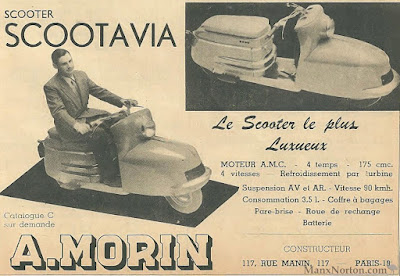Might be the emergence of various designs of scooters at the beginning of its development in the 1950s can be connected indirectly to the large numbers of aircraft designers who suddenly lost their jobs shortly after the 2nd World War ended. At that time many manufacturing industries were closed because many of the plants were destroyed into pieces affected by the war or as economic downturn results.
 |
| André Morin in person on one of the first advertisements for the Scootavia AMC 175 where the new hull does not have its gills of aeration of the engine. (Picture from: Motor-Collection) |
The economic downturn also coincidentally resulted in also lowering the financial capabilities of a large number of European societies in the time, even making them can't afford to buy a car so that it encouraged some of them (who previously designed the aircrafts) to make a vehicle that was as reliable as a car but had more affordable price, then was born the scooter-typed vehicle.
 |
| One of the first Scootavia built models on display at the Vittorio Tessera's scooter museum in Rodano near Milan. (Picture from: Motor-Collection) |
Are You still remember to Corradino D'Ascanio? An Italian gentleman who previously worked as an aeronautics expert, aircraft designer then succeeded in making the legendary scooter design for Innocenti and Piaggio that globally changed the face of the world of the automotive industries at that time.
It can't be denied, many of the scooter designers are those who originally worked in the aircraft industry as aeronautic experts, engineers, technicians, and others. So it is not surprising that many of the designs and use of materials inspired by the world of the aircraft industries.
 |
| Sales brochure of the 1948 Aerocar, a three-wheeled vehicle designed by André Morin. (Picture from: Motor-Collection) |
 |
| The Scootavia AMC 175 shown off at the 1952 Paris Salon de l'Auto. (Picture from: CyberMotorcycle) |
This is not much different from a scooter produced by a French manufacturer called Scootavia. This French scooter brand founded by André Morin. He known as an aeronautical engineer who has a passion for engineering and design was unmistakable, even at a young age. It made him able to work in the design office of Devoite Arado and Farman in Paris on a seaplane project capable of crossing the Atlantic.
 |
| The 1950 Scootavia uses the Ydral's 125 cc engine, combined with the 4-speeds manual transmission system. (Picture from: CyberMotorcycle) |
Shortly after the war ended, he designs a single-seat airplane that leaves due to a lack of means. Then in 1947, he started in the construction of automotive wheels rims removable light alloy. It continues from the wheel to the microcar in 1948, he designed a three-wheeled vehicle named Aerocar dressed with dural sheets or plastic but the project was unsuccessful in the market, due to considered too expensive at the time.
 |
| The 1951 Scootavia uses the AMC's four-stroke 175 cc engine, combined with the 4-speeds manual transmission system. (Picture from: CyberMotorcycle) |
After the Aerocar project stalled, then in 1949, he switched to the scooter project which was named Scootavia. The Scootavia name is taken from the combination of the words of Scoot from 'scooter,' and Avia from 'plane.' Most of the scooter design was inspired by the Bernardet A48 scooter had been launched a year earlier. The construction of the Scootavia scooter-designed by André Morin is entirely using light alloy materials, apart from precisely this large fixed nose welded sheet.
 |
| Sales brochure of the Scootavia AMC 175. (Picture from: CyberMotorcycle) |
Scootavia were luxurious and innovative scooters fitted initially with the Ydral's 125 cc engine, it first time advertised in 1949 then started to production probably early in 1950. In 1951 there was a design change along with a new engine, the AMC's four-stroke 175 cc combined with the 4-speeds manual transmission system. Then there was an association with M. Petigat, who made the scooter under license from 1952 until the end of production in 1954.
 |
| 1950 Scootavia Tripousse on display at the Lane Motor Museum. (Picture from: LaneMotorMuseum) |
During the manufacturer's production period, it is known that the company has been built approximately 140 units of scooters and only 18 units known to exist today including a very rare (and possibly one-off) triporteur styled vehicle, the Scootavia Tripousse.
 |
| André Morin (87 yo.) in December 2010 posed along with his two scooter-creations, the Scootavia AMC 175 (left) and the Scootavia 125 (right). (Picture from: Scootavia.Over-blog) |
Kept spur your adrenaline on the power of the two-wheeled monster and stay alive with true safety riding. May God will forgive Your sins and
so does the cops...... *** [EKA | FROM VARIOUS SOURCES | SCOOTAVIA.OVER-BLOG | DESKGRAM | CYBERMOTORCYCLE | MOTO-COLLECTION.ORG | LANE MOTOR MUSEUM ]
Note: This blog can be accessed via your smart phone.













































